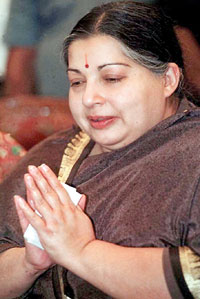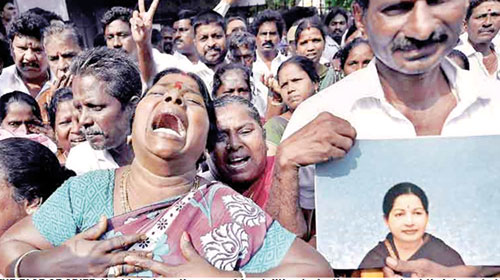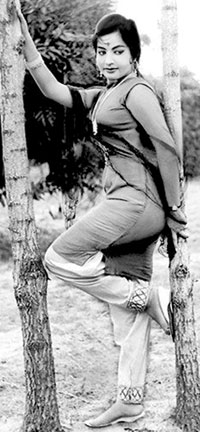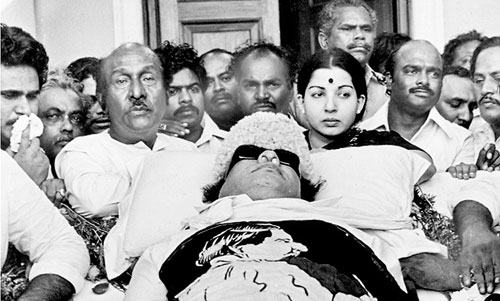Columns
Jayalalithaa leaves Tamil Nadu a ‘motherless child’
View(s):- Grieving, weeping, breast beating Tamil state wails for her dead red rose
- From nautch girl to love goddess of the Tamil silver screen to political leader to chief minister to become a people’s ‘Amma’

THE FINAL FAREWELL: Jayalalitha Jayaram whom Tamil Nadu’s people called their ‘rosaappoo amma’ — the lady as beautiful as a rose
Of the dead, nothing but the truth. But as they laid Jayalalithaa Jayaram to her grave last Tuesday evening and buried her in a casket of sandalwood, part of that truth and part of the Tamil aspirations that lay reposed in her were coffined with her under a canopy of a thousand rose petals.
Whatever history may hold for her, this was no time for the truth. Whatever faults she may have had, it was all forgiven, washed and cleansed by the flood of tears that fell from millions of grieving hearts, tears as sacred as the waters of the Ganges, with the all redeeming power to purify all sins.
This was the moment Tamil Nadu had dreaded ever since she was admitted to hospital on September 22 for an undisclosed illness. Thousands, perhaps millions, prayed for her recovery and poojas were held daily at kovils throughout the state imploring the Gods to save their Chief Minister and restore her to their midst. But hope turned to despair last Sunday afternoon when the news broke that she had suffered a heart attack and that her condition had turned critical.
Thousands kept vigil outside the hospital where she lay comatose, their hearts palpitating with every difficult breath she drew with the aid of a life-support machine, praying for a miracle that never came. The end, they knew, was nigh after the top team of doctors who attended on her issued a brief statement saying they had ‘done their best for her’; but they refused to countenance the worsening reality or accept the inevitable advent of Mara, the King of Death.
And now the fight, this final fight for life, was hers alone to wage but with Hope’s eagle beginning to flap its wings and rearing to take flight, the prospects turned bleak and the people’s hearts turned forlorn. And when, thirty minutes before Monday’s midnight hour gonged, it was announced that she had died, Tamil Nadu was left a motherless child.
For she was their Great Amma, their great mother and now she was gone, left them orphaned. With grief in every heart, with tears in every eye, with wails in every voice Tamil Nadu broke down and cried.
At that moment it became patently clear, that whatever else history may indict her for in the years to come, it will solemnly swear today that this was the most loved Tamil of them all: that though her life was turbulent and though the elements of both vice and virtue, of vengeance and compassion, of poverty and prodigality were so insanely mixed in her to confound reason, still some primordial spark of divinity flared within her, that moved the people of Tamil Nadu – 50 million of them – to momentarily rise from their grief and attest in one breaking voice “ this was a woman’.
No other woman in India’s post independence history – not even India’s Indira who had the Nehru family name and the Gandhi tag behind her – has been able to singularly command the affection of her people to the degree Jayalalithaa did. The people’s love did not border on adulation alone but extended to the exalted realms of devout worship. She was not sanctified by any pope but deified by her people who placed her photograph, sold in shops and on the pavement in Chennai, in their shrines at home and adored her as one of their household gods.
 She epitomised Tamil Nadu’s grace and warts; her poverty and her riches; and her sari draped rotund figure became its symbol and her round full moon face, its thilaka; and she reigned – whether in office or out – as its uncrowned empress. She became the voice of her people who now, bereft of articulate speech, can only express their grief in mournful wails. She cut a dash on the national or even the international stage as no other woman of India since Indira Gandhi had done. And with her death at the age of 68, she gained immortality in the hearts of her people who used to kiss the ground she walked on whilst alive. If the poverty striken masses of Tamil Nadu had prayed for a lesser god to answer their manifold wishes, she was ‘it’: and she assumed the pedestal without a blush to grant their pleas.
She epitomised Tamil Nadu’s grace and warts; her poverty and her riches; and her sari draped rotund figure became its symbol and her round full moon face, its thilaka; and she reigned – whether in office or out – as its uncrowned empress. She became the voice of her people who now, bereft of articulate speech, can only express their grief in mournful wails. She cut a dash on the national or even the international stage as no other woman of India since Indira Gandhi had done. And with her death at the age of 68, she gained immortality in the hearts of her people who used to kiss the ground she walked on whilst alive. If the poverty striken masses of Tamil Nadu had prayed for a lesser god to answer their manifold wishes, she was ‘it’: and she assumed the pedestal without a blush to grant their pleas.
So how did she do it? How did she wring a miracle for her own self to rise from the pecuniary mire e’en though her lotus did not bloom unstained but rose over the water mark with her petals blemished with clinging mud?
She was born in Mysore, in India’s southwestern Karnataka state, on February 24, 1948 and was named Komalavallie. With her lawyer father dying, in mysterious circumstances when she was only two years old, after running through his inheritance, it fell upon her ambitious mother to raise the ugly duckling and turn her into a swan. To ward off the insistent knock of rising debt from the family door, Komalavallie had not only to give up her studies but her name too when renamed as Jayalalitha, she was pushed into the glamour world of Tamil cinema at the tender age of 15 by her mother, herself a two bit actress in B grade Tamil movies.

THE FACE OF GRIEF: Unable to bear the news of Jayalalithaa’s death, mourners beat their breasts to give vent to their irreprehensible sorrow
Behind most successful women, there is always a man. For the world’s first woman prime minister Sirima, it was her slain husband SWRD. For India’s first woman PM Indira, it was her sire Jawaharlal Nehru. And even though she lost the chance to be America’s first woman president by a whisker, Hillary had her Bill. For Jayalalithaa, it was her movie co star, her mentor and her lover M. G. Ramachandran, the first superstar the Tamil film world had ever known: the living demi-god of Tamil Nadu State. She was to become his consort; and though she faced many battles with rival concubines to maintain her place and status as his most fancied mistress, she won the day to remain so until his death in 1987.
And with his death, her star, long eclipsed by his super sun, broke through the twilight of his demise, rose to shine unchallenged and undimmed thereafter. She had joined the AIADMK political party he had founded and on his death wrested control of it in the face of great opposition waged by MGR’s widow Janaki’s faction. She had tasted blood and she quickly acquired a cultivated penchant for it and, after purging the party from all dissenters, announced she was MGR’s political heiress.

THE STARLET: She dominated the Tamil silver screen as its Love Goddess
In 1991, at the age of 43, she became the youngest Chief Minister of Tamil Nadu. But in the election that followed in 1996, her party was wiped out at the polls and she herself suffered ignominious defeat by losing her own seat. During this period the new government filed corruption charges over a land deal against her and she was convicted; and in the 2001 election, though her party won, she was disbarred from contesting due to the corruption conviction. After being acquitted of the charges by the Supreme Court, she returned to her post as Chief Minister. In 2006 she lost again only to bounce back in 2011 with a landslide victory. Bouncing back from a spell of adversity was nothing new to Jayalalithaa. She had always fought against the odds and come back from each downturn in her life with renewed vitality and vigour.
However the 2001 scenario was to be repeated again in 2014, when she was unseated and forced to relinquish her Chief Minister post after a Karnataka state court found her guilty in the disproportionate assets case and she was sentenced to 4 years jail, effectively ending her political career. But her guardian gods worked in mysterious ways, when not even eight months into her sentence, a single Karnataka High Court judge allowed her appeal, cleared her of all charges and set her free, to be sworn in again as Chief Minister of Tamil Nadu in May 2015. At this year’s election in May, she became the only Tamil Nadu chief minister next to her mentor MGR to be voted for a second consecutive term, her fourth as chief minister.
But while a manmade court may have granted her temporary reprieve from serving the sentence her karmic force had ordained, fate’s inexorable stride soon caught up with her. Not even five months after her fourth triumph at the polls, inscrutable providence sentenced her to the narrow confines of a hospital bed, imprisoned by a mystery illness for the remainder of her life. It happened on September 22nd this year, exactly five days before the day two years ago – 27 September 2014 when she was first jailed by an earthly court for four years.
But in her death, the long litany of her corruption, her vulgar extravagances, her rapacity, her power abuses, her vengefulness, her angers, her discriminations were all forgotten and forgiven by the teeming masses of this southern state of India who had turned this former nautch girl turned sex siren of the Tamil screen turned political leader turned chief minister into their great Amma and placed her in their hearts and in their shrines as an earthly manifestation of the divine Mother. All they remembered in the squalor of death was the vitality of her life and the generous spirit that always appeared to help the poor. Without the Amman, the light had gone out of their own sordid lives.
In Lanka too, the catalogue of her actions aimed to establish a separate state of Eelam on this island, her patronage of Tamil terrorism as God Mother to the Tigers, her repeated calls to the Indian Central Government to intervene in Lanka’s sovereign affairs, her demand for the Lankan owned isle of Katchatheevu to be returned to India notwithstanding its ceding by India to Lanka by treaty in 1976, the incessant affirmation of the right of Tamil Nadu fishermen to poach in Lanka’s territorial waters were cast aside at death’s melancholic moment. Both President Sirisena and former president Rajapaksa have risen above base instincts to harbour ill will toward the dead and issued their own statements on her death though they both expressed the same sentiments more or less in the same words.
President Sirisena said “Chief Minister Jayalalithaa was a leader dearly loved by her people. I express my condolences to her loved ones and the people of Tamil Nadu,” while Rajapaksa tweeted, “ Tamil Nadu Chief Minister Jayalalithaa captured the hearts of India’s Tamil community. My condolences to the family and people of Tamil Nadu”. For both Lankan leaders, discretion, it seems, was the better part of valour.
Lanka’s northern chief minister Wigneswaran who heavily depended on her to deliver his dream Eelam may be distraught today that with her death, the Tiger cause he is espousing since of late has lost the benefit of Jayalalithaa’s championing roar.
And what of Jayalalithaa? What of the woman Tamil Nadu called their ‘rosaappoo amma’ — the lady as beautiful as a rose? Whatever her weaknesses, whatever her vices may have been, it is undeniable that she was a great being who was relentlessly led by her karmic line of destiny.
As she said in a rare interview given to the media, “My mother pushed me into being an actress, MGR pushed into being a politician. I would never have been either if not for these two great influences in my life. If not for them, I would have run away from it all.”
To her credit, despite her professed disinclinations, she reached the zenith in both fields. For she had the Masses touch, and everything she turned her hand to, touched the people’s heartstrings and turned triumphant.
In a nation dominated by male chauvinism, for a lone woman, without the crutch of a political family name or the advantage of inherited wealth or education – not even O’ levels – to have climbed each flawed step of the political ladder while scores of rivals were tugging at her sari to bring her crashing down; and to have reached the top most rung of state politics and with every fall to have risen again and again with her eyes set on becoming the next prime minister of India, is, by any standard, no mean achievement but one to be admired and acclaimed.
In November 2003, a two-judge bench of India’s Supreme Court acquitted her of corruption in the land deal case and paved the way for her to become Chief Minister again. In a verdict that shocked the nation and the judiciary, Justice Rajendra Babu held that though there was strong suspicion that Jayalalithaa had acted illegally, it did not amount to legal proof to justify the conviction and that he was freeing Jayalalithaa ‘to atone her conscience in the whole controversy”. Whether Jayalalitha ever answered to her conscience, ever cleared it of remorse and, even in the final moment before death, found the elusive peace which she never found during her lifetime, is a secret not even her sole long time confidential aide, the controversial Sashikala would ever know.
Of the dead, nothing but the truth. But though today it lies buried in a Marine Beach grave under a heap of fading rose petals, someday no doubt, the truth will sprout.
| FLASHBACK: Jaya’s coffin battle with MGR’s widow Jayalalithaa’s greatest strength lay in her iron will. And her remarkable trait had been to meet life’s upheavals head on. Following Confucian wisdom, she had not remained downhearted in falling but upbeat and determined to rise every time she fell. And if perseverance had been her chief virtue then ruthlessness had been her rapier to slash and thrust through each obstacle that stood in her rise to become Tamil Nadu’s first pin up girl and then its first citizen as its powerful chief minister.  The STOIC VIGIL: Spent a day without moving from MGR’s corpse at his funeral Consider how Komalavallie, with a name change to Jayalalithaa, became the sultry southern siren to take the Tamil film world by storm, and then audaciously usurped demi god M. G. Ramachandran’s political mantle by sheer will and daring, and you will have a fair idea of the mettle she was made of: proven steel that had withstood the test of fire, that had gone through the Tamil Nadu furnace of political life and emerged stronger. For long his favourite actress, the then 39 year old Jayalalitha storms the residence of MGR the moment she learns he had died. On the orders of MGR’s 64 year old wife Janaki who had remained in her husband’s shadows for 24 years and had surprisingly laid claim to the leadership, the security personnel at the gate prevent Jayalalitha from entering but, sweet talking her way through the gates, she rushes to MGR”s bedroom where he lay dead, only to find the door locked and entry barred. Though rebuffed, she is not daunted. Neither is she dismayed. She is made of sterner stuff and uses her acting histrionics to the fullest. The next day when the body is unveiled for public viewing she places herself at the head of the coffin and waits standing there for almost a day without budging an inch. To the millions of mourners who file past the corpse and watch the scene live on television at their homes, she appears as the rightful claimant to the enduring legacy MGR left behind. This is where the buck stops, she seems to announce; and, though family members pinch her, jostle her and even step on her toes, she doesn’t move a tyre of fat but stands her ground, glued to the spot depicting herself as the sympathy evoking figure of the grief wracked widowed mistress to the watching masses. When the time comes for the funeral procession to begin, and the body is kept on the gun carriage, Jayalalitha, without the slightest warning, jumps onto it and holds on as the carriage begins to move. However this proves too much for MGR’s nephews to bear and they reach out and pull her; and Jayalalitha ignominiously crashes to the ground. But she rises in triumph the next day when the newspapers report how she had outmaneuvered MGR’s widow and ousted her in the battle for the coffin and for the AIADMK leadership. The AIADMK splits, with MGR’s wife leading one faction and Jayalalitha commanding the other. Soon Jayalalitha succeeds in outmaneuvering the widow and the party unites under her sole leadership. In the 1991 elections the AIADMK sweeps the polls and Jayalalitha becomes the powerful chief minister of Tamil Nadu. The rest is history. | |


Leave a Reply
Post Comment